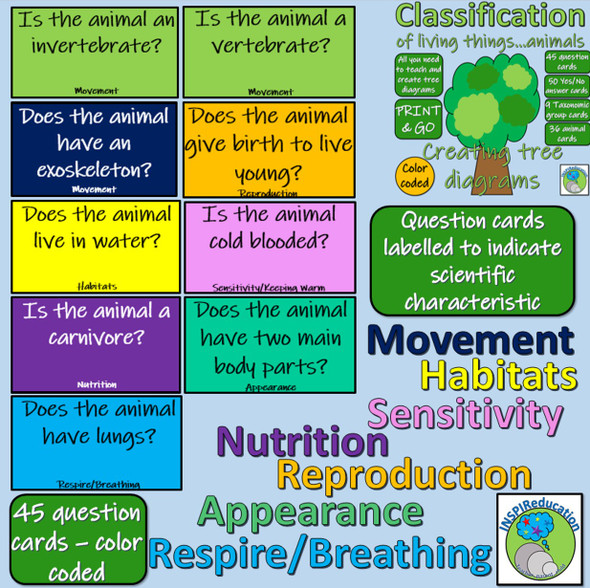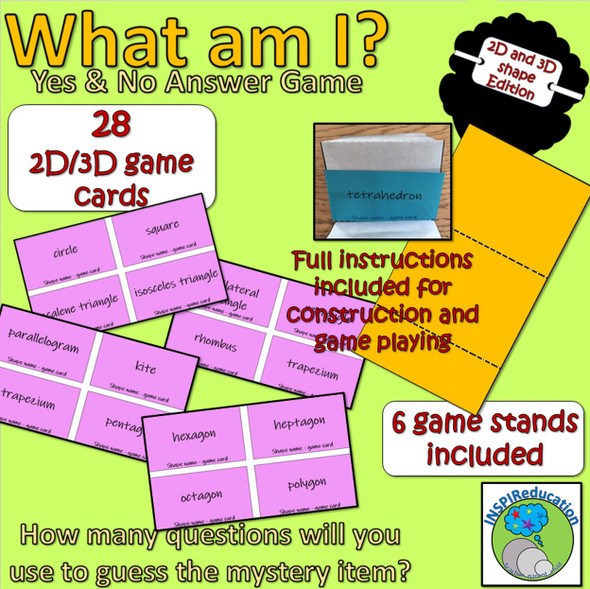Classification of 2D and 3D shapes - Tree Diagrams (Yes/No Branch diagrams)
- Bulk Pricing:
- Buy in bulk and save
- Contributor:
- INSPIReducation
- Grade Level:
- 3, 4, 5
- Product Type:
- Card Game, Resource, Instructions included
- File Type:
- ZIP, PDF
- Pages:
- 34
- Answer Key:
- N/A
Description
We have developed this resource over the past few years to support children in their knowledge of 2D and 3D shape classification and their skills in developing yes/no questions to build a tree diagram.
Once purchased and downloaded, open the ZIP and open the main document.
Color print the document to benefit from the color coded question cards – 34 pages of resources and instructions, including:
- 38 questions cards
- 50 yes/no cards
- 25 2D and 3D shape cards
To maintain the quality of the document when using on a regular basis, laminate each page to keep the resource in good condition for longer. This will also strengthen each of the cards without having to print on card.
Your resource is now ready for use.
When used in our classrooms, we have started with a whole class session. We have sorted each of the cards into their groups and shown the children what each card says.
As a starter, we provide the children with two different shape cards, for example a 2D shape and a 3D shape.
We ask the children to think of a question with a yes/no answer which will separate the two shapes (square and cube). For example: “Is the shape 2D?” This will provide a yes answer for the 2D shape (Square), and a no response for the 3D shape (cube).
Present this on a shared board for the children to see the tree diagram developing.
Now introduce a third shape – another 2D shape - Triangle.
Repeat the first question – is the shape 2D?
The answer is yes, so the triangle will join the square.
The children should then be told that two shapes cannot be together – so therefore they must think of another question to separate the square from the triangle.
For example: “Does the shape have four right angles?”
This would answer yes for square and no for triangle.
The lesson can then continue until a number of shapes have been sorted using a range of questions.
Once the tree diagram has been completed, leave all of the questions in place and remove the shape names.
Can the children work out where each group label should go using the questions?
When confident, children can use the activity in groups to challenge one another:
- Who can make the largest tree using the most questions?
- Who can make the smallest tree using the least amount of questions?
- Who can complete the activity the fastest?
- Who can sort all 2D and 3D shape cards using the tree diagram?
Who can create a tree independently?
Evidence of learning can be taken using photographs of achievements. Learning can also be placed on display boards so that classroom visitors can see how the children are developing their knowledge of 2D and 3D shape characteristics and sorting skills using specific, mathematical questioning to classify shapes.
We have found that this activity has always been successful. It takes the laboriousness of writing out questions for the children, and if they want to add their own questions, they can make their own cards.
Such is the success that children can use it independently, adding their own questions, as a math center and as home learning, taking a photo of what they achieved and bringing the evidence back into school.
Thank you for viewing our products.
Best wishes
INSPIReducation.


















